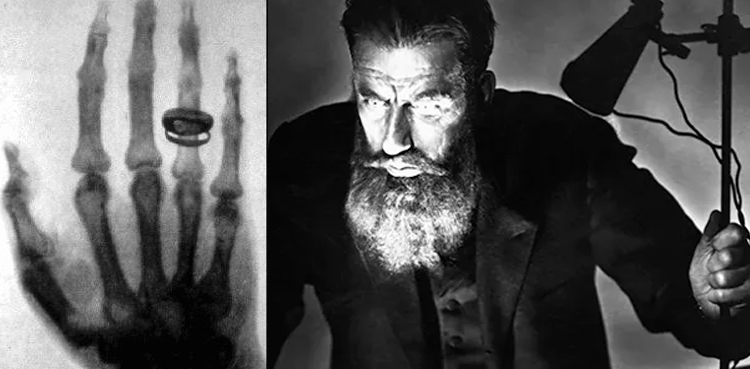
Wilhelm Conrad Roentgen hailing from Ruhr section of western Germany but for most of his early life he lived outside Germany.
In 1868 he graduated from college with a degree in mechanical engineering and decided to go on for advanced degrees in Zurich where he came under the influence of a well-known physicist, August Kundt.
Under him, Roentgen became interested in physics and received his doctorate in that subject.
Roentgen rose steadily in his profession and in 1888 a new institute of physics was opened at the University of Wurzburg in Bavaria and Roentgen was invited to head it. It was there that he discovered his penetrating rays and won world fame.
Professor Roentgen was fascinated by the mysterious illumination that resulted when electricity was discharged in a tube from which all the air had been pumped. The eerie illumination inside the tube seemed to start at the negative electrode, or “cathode,” so the phenomenon was referred to as “cathode rays.”
When the rays hit the glass of the tube, the glass glowed with a greenish light. Certain chemicals placed near the tube glowed even more brilliantly than did the glass.
Roentgen was particularly interested in the luminescence.
On 5 November, 1895, he enclosed his cathode ray tube in a box made of thin, black cardboard and darkened the room. Thus he would be able to observe the luminescence without the interference of outside light.
He turned on the electricity. Almost at once a flash of light that did not come from the tube
caught his eye. Quite a distance from the tube, he happened to have a sheet of paper coated with barium platinocyanide.
He used the paper in his experiments because barium platinocyanide was one of the chemicals that glowed when placed near the cathode ray tube. But why should it be glowing now?
The tube was in a cardboard box. Roentgen turned off the electricity. The coated paper became dark. He turned on the electricity again. The paper glowed once more. He walked into the next room with the coated paper, closed the door, and pulled down the blinds. The paper continued to glow while the tube was in operation.
He had discovered something invisible that was felt through cardboard and closed doors. The mysterious rays that caused chemicals to luminesce through cardboard and doors were called “Roentgen rays” in honour of the discoverer.
Roentgen himself, in honour of their unknown nature, gave his rays the mathematical symbol for the unknown calling them X-rays.
He found what thicknesses of various materials could be penetrated by X-rays. He discovered that they would fog a photographic plate just as sunlight would. He published his results on 28 December, 1895.
The scientific world was amazed.
A number of scientists found that they had encountered these mysterious rays. Roentgen’s work caught the imagination of a French scientist, Antome Henri Becquerel, who in February, 1896 wrapped photographic film in black paper put it in sunlight and put a crystal of a fluorescent chemical upon the paper.
He used a chemical his father had been particularly interested in a uranium compound. Sure
enough, when the film was developed it was found to be fogged. Ordinary sunlight would
not have passed through the black paper but X-rays could.
Becquerel decided the uranium salt was giving off X-rays as it fluoresced and he decided to develop some of the films anyway.
He quickly found that exposure to sun was unnecessary as Uranium salts gave off a radiation constantly one even more penetrating than X-rays. By 1897 the nature cathode rays was established.
J. J. Thomson, an English physicist, showed that the rays consisted of tiny particles speeding at breakneck velocities. What was more these particles were much smaller than atoms. They were the first subatomic particles to be discovered and were called electrons.
When these speeding electrons (or cathode rays) struck the anode in a cathode ray tube, X-rays were produced.
These X-rays were part of the electromagnetic spectrum, of which visible light is another
part. As for Becquerel’s uranium rays, these proved to consist of three parts.
The most penetrating part, called gamma radiation, was similar to X-rays but more energetic. The rest of the radiation was made up of electrons and helium nuclei.
Roentgen’s discovery, from the standpoint of pure science, was supremely important but before that became apparent to the average man there was an immediate advance in medicine that affected almost everyone.
X-rays penetrate the soft tissues of the body easily but are largely stopped by bone and entirely stopped by metal. X-rays, passing through the body to a photographic film behind, show light gray where bones stop most of them, gray and fogged in varying degrees elsewhere.
Doctors found they had a way of looking into the human body quickly, easily and-above all-without cutting. Small breaks in bones could be discovered; disorders in the joints; the beginnings of tuberculosis in lungs and foreign objects in the stomach.
In short, the doctor had a kind of magic eye at his disposal and this point was proven when only four days after news of Roentgen’s discovery reached America, X-ray located a bullet in a patient’s leg.
X rays (and gamma rays) can kill living tissue and if focused properly can kill cancer cells which the surgeon’s knife cannot reach.
Today, however, it is known that they must be used with caution and only when necessary. In industry, too, X-rays are used. They can detect internal flaws in the structure of metals, flaws that would be invisible otherwise.
In chemistry they are used to probe the atomic structure of crystals and of complex protein molecules.
In both cases, they open new windows into what was previously hidden. Thanks to Roentgen, doctors can—odd though it sounds—use the invisible to make the invisible visible.
from Science and Technology News - Latest science and technology news https://ift.tt/AwTSiIP



